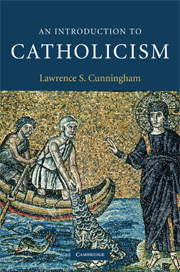Book contents
- Frontmatter
- Contents
- Illustrations
- Preface
- Acknowledgments
- 1 The many meanings of Catholicism
- 2 Roman Catholicism
- 3 Being Catholic: Some typologies
- 4 Catholicism in place and time
- 5 Catholic worship
- 6 The rule of faith
- 7 Catholic spirituality
- 8 The missionary character of Catholicism
- 9 Catholic reformation(s)
- 10 The moral life
- 11 The contemporary Catholic Church
- 12 Reading Catholicism: Bibliographical resources
- Index
- References
2 - Roman Catholicism
Published online by Cambridge University Press: 05 June 2012
- Frontmatter
- Contents
- Illustrations
- Preface
- Acknowledgments
- 1 The many meanings of Catholicism
- 2 Roman Catholicism
- 3 Being Catholic: Some typologies
- 4 Catholicism in place and time
- 5 Catholic worship
- 6 The rule of faith
- 7 Catholic spirituality
- 8 The missionary character of Catholicism
- 9 Catholic reformation(s)
- 10 The moral life
- 11 The contemporary Catholic Church
- 12 Reading Catholicism: Bibliographical resources
- Index
- References
Summary
INTRODUCTION
Even though, as we saw in the first chapter, the adjective “Roman” added to Catholicism can be misunderstood, it is clear that it is the city of Rome in general and the bishop of Rome, known more familiarly as the “pope,” in particular that gives Catholicism its defining character. After all, unity with the bishop of Rome is the linchpin that guarantees the unity of Catholicism. More than anything else, the division of Orthodoxy and Catholicism is best exemplified by the fact that Orthodoxy is not in union with the bishop of Rome, the pope. Both the Orthodox Church and the Byzantine Rite of the Catholic Church use the same liturgy ascribed to Saint John Chrysostom but the difference is that during the liturgy the Byzantines pray for the bishop of Rome and the Orthodox do not. At a more popular level, Catholicism is almost instinctively identified with the papacy. Even the popes themselves, in recent times, have acknowledged that the papacy is a stumbling block for other Christians.
It would be, however, the most naive idea to think that as Christianity developed there was already in place a full-blown papacy as we understand the papacy today. The papacy, with all of its claims of authority and the very central role that it plays in the Catholic Church today, is the result of a very long historical evolution.
- Type
- Chapter
- Information
- An Introduction to Catholicism , pp. 23 - 48Publisher: Cambridge University PressPrint publication year: 2009



